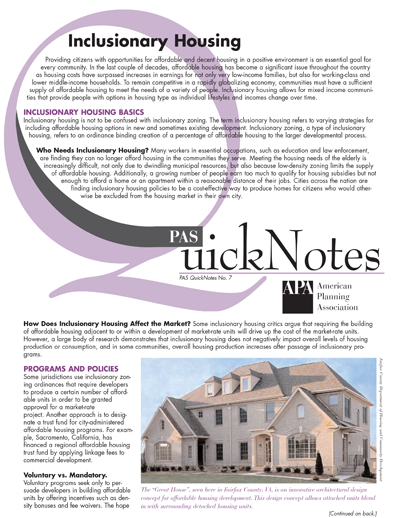Promote Inclusionary Growth
Concentrated poverty impedes economic mobility in communities and regions. "Fair share" approaches are necessary and proximity to jobs, accredited schools, and mobility services are key determinants of specific spatial requirements for inclusive housing. Truly inclusive housing is mixed-income, with market and subsidized units — whether rented or owned — in close proximity to avoid stigmatizing residents or owners of the affordable units.
essentials of Inclusionary housing

Further inclusionary measures use a proactive approach to preserving affordable housing units by exercising strategic property acquisition in current and future transit corridors. This ensures that transit-dependent populations in developing or redeveloping areas will have continued access to jobs, schools, health care, goods and services, and more.
Achieving the goal of truly inclusive growth requires policies that allow everyone to reap the benefits of economic growth and prosperity. Taking steps to mitigate the effects of gentrification and rising housing costs on existing residents can advance both social equity and support for new development. Innovative policy approaches can give current residents a genuine stake in housing and development while helping new residents access housing opportunity.
Too often, housing regulations and practices have resulted in the creation of communities stratified by income or separated by race or ethnicity. Although the forces obstructing the creation of truly diverse communities are formidable, increasing mandates to remove impediments and judicial decisions that assign liability regardless of intent compel inclusionary practices.
details can vary
While inclusionary zoning may take different forms, the most common mandates specify that a minimum percentage of affordable units in a building or project be set aside in exchange for greater density. Others allow for a prorated number of affordable units that may be provided offsite; still others allow for payment to a dedicated fund for use by others. States can support and enable these and other tools to foster inclusive growth and expanded housing opportunity across all communities.
Dig In
These APA resources illuminate the issue and prepare you to act in your community.
-

Planning Home Case Study: Washington, D.C.
Inclusionary Zoning Implementation Amendment
The D.C. Office of Planning and the Zoning Commission began work in 2005 to conceptualize and draft an inclusionary zoning program. That effort coincided with the adoption by the District Council (i.e., the city council) in 2006 of the Comprehensive Plan. The plan's housing element furthered the goal of both increasing the number of affordable housing units and expanding the geographic distribution of affordable housing across the city.

Zoning Practice
Leveraging Affordable Housing Through Upzoning


